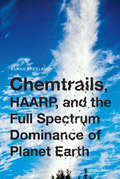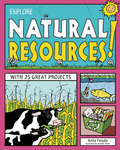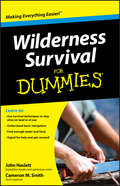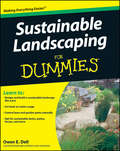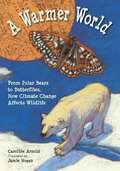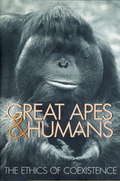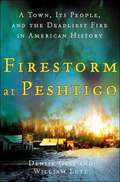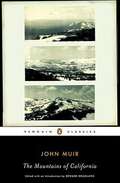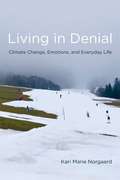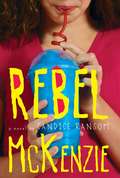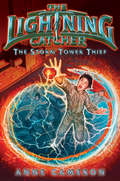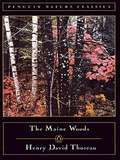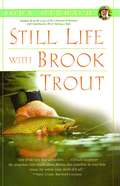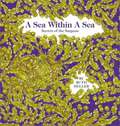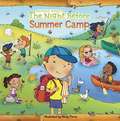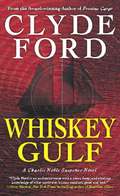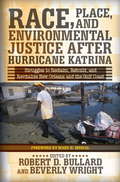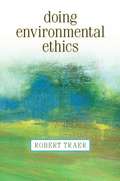- Table View
- List View
Chemtrails, HAARP, and the Full Spectrum Dominance of Planet Earth
by Elana FreelandWe are entering a Space Age, but not the kind President Kennedy originally envisioned. This Space Age is replacing resource wars and redefines planet earth as a "battlespace" in accordance with the military doctrine of "Full-Spectrum Dominance."This book examines how chemtrails and ionispheric heaters like the High-frequency Active Auroral Research Project (HAARP) in Alaska services a full-spectrum dominance. This "Revolution in Military Affairs" needs an atmospheric medium to assure wireless access to the bodies and brains of anyone on Earth--from heat-seeking missiles to a form of mind control.How sinister are these technologies? Are we being prepared for a "global village" lockdown? The recent release of NSA records have reminded Americans that "eyes in the sky" are tracking us as supercomputers record the phone calls, e-mails, internet posts, and even the brain frequencies of millions.Elana M. Freeland's startling book sifts through the confusion surrounding chemtrails-versus-contrails and how extreme weather is being "geo-engineered" to enrich disaster capitalists and intimidate nations.A deconstruction of Bernard J. Eastlund's HAARP patent points to other covert agendas, such as a global Smart Grid infrastructure that enables access to every body and brain on Earth, a "Transhumanist" future that erases lines between human and machine, and Nanobiological hybrids armed with microprocessers that infest and harm human bodies.
EXPLORE NATURAL RESOURCES!
by Anita Yasuda Jennifer KellerWhat are natural resources? And why is it important to prevent natural resources from being wasted? Explore Natural Resources! answers these questions. The 25 projects inspire young readers ages 6-9 to have fun while learning why natural resources are important to all living things and how every child can take care of the earth's resources through reducing, reusing, and recycling. Kids will read about national parks and early environmentalists, Earth celebrations, and the science behind renewable and nonrenewable resources. With projects and experiments ranging from making a wind-powered car and creating a solar catcher to calculating their water footprint, children will discover that everything comes from the earth. Projects are easy-to-follow, require little adult supervision, and use commonly found household products, many from the recycling box. Through a mixture of fun facts, trivia, jokes, comics, and hands-on activities, kids will Explore Natural Resources! and gain an appreciation of earth's resources, from its vast oceans to its open skies. Explore Natural Resources! meets common core state standards in language arts for reading informational text and literary nonfiction and is aligned with Next Generation Science Standards. Guided Reading Levels and Lexile measurements indicate grade level and text complexity.
The Economics of Climate Change
by Nicholas SternThere is now clear scientific evidence that emissions from economic activity, particularly the burning of fossil fuels for energy, are causing changes to the Earth's climate. A sound understanding of the economics of climate change is needed in order to underpin an effective global response to this challenge. The Stern Review is an independent, rigourous and comprehensive analysis of the economic aspects of this crucial issue. It has been conducted by Sir Nicholas Stern, Head of the UK Government Economic Service, and a former Chief Economist of the World Bank. The Economics of Climate Change will be invaluable for all students of the economics and policy implications of climate change, and economists, scientists and policy makers involved in all aspects of climate change.
Wilderness Survival For Dummies
by Cameron M. Smith John F. HaslettYour one-stop guide to surviving and enjoying the Great OutdoorsWant to know how to stay alive in extreme situations? This practical, accurate guide gives you all the expert, field-tested tools and techniques you need to survive. Whether you find yourself lost in the woods, adrift on a life raft, bitten by a snake, or needing shelter in cold weather, this hands-on resource teaches you how to stay safe (and sane), find rescue, and live to tell the tale!Know the basics of survival -- perform life-saving first aid, make fire and shelter, and find water and foodManage your emotions -- cope with panic and anger, get the "survivor's attitude," and foster cooperation and hope with othersIncrease your chances of rescue -- signal for help and navigate using a compass or the skyPractice expert survival methods -- tie essential knots, craft your own weapons and tools, and make natural remediesGain wisdom for water emergencies -- stay afloat when your ship or boat sinks, avoid dehydration and starvation, and make it to shoreOpen the book and find:Common survival scenarios you may encounterTried-and-tested advice for individuals or groupsThe items you need to stay aliveBasic orientation skillsWays to keep warm or coolThe best methods for building a fire in any environmentWhat you can (and can't) eat and drink in the wildTrue stories of survival
Sustainable Landscaping For Dummies
by Owen E. DellSustainable Landscaping For Dummies provides hands-on, how-to instruction for realizing the benefits of a sustainable landscape, from selecting sutainable hardscape materials to installing a rain-water catchment system to choosing native plants.
A Warmer World
by Caroline Arnold Jamie HoganAdapt, or face extinction. The golden toad used to inhabit the cloud forests of Costa Rica, but when the weather became too warm and dried up the pools where its eggs hatched, the golden toad disappeared. It has not been seen in more than twenty years. This amphibian is just one of several species in A WARMER WORLD, a thought-provoking and informative account of how global climate change has affected wildlife over the past several decades. Species by species, acclaimed nonfiction children's author Caroline Arnold describes how warmer weather alters ecosystems, forcing animals to adapt or become extinct. Arnold's clear and straightforward text is complemented by Jamie Hogan's collage-style illustrations. Reminiscent of a nature journal, the book will inspire readers to start their own research into this significant global issue. A glossary and listing of websites and books for further exploration is included.
Great Apes and Humans
by Michael Hutchins Terry L. Maple Bryan Norton Tara S. Stoinski Benjamin B. BeckThe great apes -- gorillas, chimpanzees, bonobos, and orangutans -- are known to be our closest living relatives. Chimpanzees in particular share 98 percent of our DNA, and scientists widely agree that they exhibit intellectual abilities long thought to be unique to humans, such as self-awareness and the ability to interpret the moods and identify the needs of others. The close relation of apes to humans raises important ethical questions. Are they better protected in the wild or in zoos? Should they be used in biomedical research? Should they be afforded the same legal protections as humans?Great Apes and Humans is the first book to present a spectrum of viewpoints on human responsibilities toward great apes. A variety of field biologists, academic scientists, zoo professionals, psychologists, sociologists, ethicists, and legal scholars consider apes in both the wild and captivity. They present sobering statistics on the declining numbers of wild apes, specifically discussing the decimation of great ape populations due to wild game consumption. They explore the role of apes in the educational missions of zoos as well as the need for sanctuaries for wild ape orphans and former research subjects. After examining the social division between apes and humans from historical, evolutionary, and cognitive perspectives, they conclude by reviewing the current moral and legal status of great apes as well as how apes' cognitive skills inform these issues.Although this provocative book contains many different opinions, the uniting concern of the contributors is the safety and well-being of great apes. Only by continuing the dialogue so clearly presented here can we hope to ensure their future.
Firestorm at Peshtigo: A Town, Its People, and the Deadliest Fire in American History
by Denise Gess William LutzA riveting account of a monster firestorm - the rarest kind of catastrophic fire - and the extraordinary people who survived its wrath. On October 8, 1871 - the same night as the Great Chicago Fire - an even deadlier conflagration was sweeping through the lumber town of Peshtigo, Wisconsin, 260 miles north of Chicago. The five-mile-wide wall of flames, borne on tornado-force winds of 100 miles per hour, tore across more than 2,400 square miles of land, obliterating Peshtigo in less than one hour and killing more than 2,000 people. Firestorm at Peshtigo places the reader at the center of the blow-out. Through accounts of newspaper publishers Luther Noyes and Franklin Tilton, lumber baron Isaac Stephenson, parish priest Father Peter Pernin, and meteorologist Increase Lapham - the only person who understood the unusual and dangerous nature of this fire - Denise Gess and William Lutz re-create the story of the people, the politics, and the place behind this monumental natural disaster, delivering it from the lost annals of American history. Drawn from survivors' letters, diaries, interviews, and local newspapers, Firestorm at Peshtigo tells the human story behind America's deadliest wildfire.
The Mountains of California
by John Muir Edward HoaglandA stirring tribute to one of America's most remote and beautiful places by one of the first modern preservationists This Penguin Classic-Muir's first book-puts a pioneering conservationist's passion for nature in high relief. With a poet's sensitivity and a naturalist's eye, Muir celebrates the Sierra Nevada, which he dedicated his life to saving, and recounts his breathtaking visits to Yosemite Valley, Kings Canyon, Sequoia Groves, and Mount Whiskey. The Mountains of California is an affecting celebration of raw nature by one of its most ardent defenders.
Living In Denial: Climate Change, Emotions, and Everyday Life
by Kari Marie NorgaardGlobal warming is the most significant environmental issue of our time, yet public response in Western nations has been meager. Why have so few taken any action? In Living in Denial,sociologist Kari Norgaard searches for answers to this question, drawing on interviews and ethnographic data from her study of "Bygdaby," the fictional name of an actual rural community in western Norway, during the unusually warm winter of 2000-2001. In 2000-2001 the first snowfall came to Bygdaby two months later than usual; ice fishing was impossible; and the skiindustry had to invest substantially in artificial snow-making. Stories in local and national newspapers linked the warm winter explicitly to global warming. Yet residents did not write letters to the editor, pressure politicians, or cut down on use of fossil fuels. Norgaard attributes this lack of response to the phenomenon of socially organized denial, by which information about climate science is known in the abstract but disconnected from political, social, and private life, and sees this as emblematic of how citizens of industrialized countries are responding to global warming. Norgaard finds that for the highly educated and politically savvy residents of Bygdaby, global warming was both common knowledge and unimaginable. Norgaard traces this denial through multiple levels, from emotions to cultural norms to political economy. Herreport from Bygdaby, supplemented by comparisons throughout the book to the United States, tells alarger story behind our paralysis in the face of today's alarming predictions from climate scientists. The hardcover edition does not include a dust jacket.
The Conquest of the Russian Arctic
by Paul R. JosephsonSpanning nine time zones from Norway to the Bering Strait, the immense Russian Arctic was mostly unexplored before the twentieth century. This changed rapidly in the 1920s, when the Soviet Union implemented plans for its conquest. The Conquest of the Russian Arctic, a definitive political and environmental history of one of the world's remotest regions, details the ambitious attempts, from Soviet times to the present, to control and reshape the Arctic, and the terrible costs paid along the way. Paul Josephson describes the effort under Stalin to assimilate the Arctic into the Soviet empire. Extraction of natural resources, construction of settlements, indoctrination of nomadic populations, collectivization of reindeer herding--all was to be accomplished so that the Arctic operated according to socialist principles. The project was in many ways an extension of the Bolshevik revolution, as planners and engineers assumed that policies and plans that worked elsewhere in the empire would apply here. But as they pushed ahead with methods hastily adopted from other climates, the results were political repression, destruction of traditional cultures, and environmental degradation. The effects are still being felt today. At the same time, scientists and explorers led the world in understanding Arctic climes and regularities. Vladimir Putin has redoubled Russia's efforts to secure the Arctic, seen as key to the nation's economic development and military status. This history brings into focus a little-understood part of the world that remains a locus of military and economic pressures, ongoing environmental damage, and grand ambitions imperfectly realized.
Chase the Wind
by Matt SimsThree people are out camping over the weekend to chase a storm and record its statistics. What happens when their anticipations and calculations of the storm's trajectory go wrong?
Rebel McKenzie
by Candice RansomWhen feisty twelve-year-old Rebel McKenzie, an aspiring paleontologist, goes to spend the summer taking care of her older sister's seven-year-old son at the mobile home park in Frog Level, Virginia, she never expects to enter a beauty pageant or meet a hand model.
Camp Cook (Sound Out Chapter Books - Set B-2)
by Matt SimsMark was at Camp Cook. He did not like it a bit. He did not like to hike or swim. He did not like to play sports. He did not like to sing. He did not like to make things.
Fun in the Hills (Sound Out Chapter Books - Set A-2)
by Matt Sims"The sun came up at six," said Ted. "With luck we can get to the top by ten." "Can we sit for a bit?" said Sam. "Can you get this pack off my back?"
Shell Beach (Sound Out Chapter Books - Set B-2)
by Matt SimsThe bus ride to Shell Beach was long. Rain beat on the glass by our side. We could not see past the gray haze.
The Lightning Catcher: The Storm Tower Thief
by Anne CameronThe funny, fast-paced second book in The Lightning Catcher series! Science, weather, and the fantastical combine for a school adventure story, part Storm Chasers and part Percy Jackson, about twelve-year-old Angus and his dangerous gift of predicting catastrophic weather.Angus has a lot on his plate. He's attending the Perilous Exploratorium for Violent Weather and Vicious Storms, learning how to battle all sorts of extreme weather. He's a Storm Prophet--one of the rare people with the ability to predict catastrophic weather. His parents--world renowned Lightning Catchers themselves--have been kidnapped. And now Perilous has been slammed by a ferocious winter storm, artifacts from the Great Fire of 1666 have been stolen, and the evil Scabious Dankheart has released deadly spores called Ice Diamonds to plague the population. Angus and his friends must find the legendary Lightning Heart--a bloodred, heart-shaped stone of great power--in order to put everything right. Action-packed, lighthearted, and perfect for reluctant readers!
The Maine Woods
by Henry David Thoreau Edward Hoagland"What a wilderness walk for a man to take alone!...Here was traveling of the old heroic kind over the unaltered face of nature." Henry David Thoreau Over a period of three years, Thoreau made three trips to the largely unexplored woods of Maine. He climbed mountains, paddled a canoe by moonlight, and dined on cedar beer, hemlock tea and moose lips. Taking notes constantly, Thoreau was just as likely to turn his observant eye to the habits and languages of the Abnaki Indians or the arduous life of the logger as he was to the workings of nature. He acutely observed the rivers, lakes, mountains, wolves, moose, and stars in the dark sky. He also told of nights sitting by the campfire, and of meeting men who communicated with each other by writing on the trunks of trees. In The Maine Woods, Thoreau captured a wilder side of America and revealed his own adventurous spirit.
Still Life with Brook Trout
by John GierachIn Still Life with Brook Trout, John Gierach demonstrates once again that fishing, when done right, is as much a philosophical pursuit as a sport. Gierach travels to Wyoming and Maine and points in between, searching out new fly-fishing adventures and savoring familiar waters with old friends. Along the way he meditates on the importance of good guides ("Really, the only thing a psychiatrist can do that a good guide can't is write prescriptions"), the challenge of salmon fishing ("Salmon prowl. If they're not here now, they could be here in half an hour. Or tomorrow. Or next month"), and the zen of fishing alone ("I also enjoy where my mind goes when I'm fishing alone, which is usually nowhere in particular and by a predictable route"). On a more serious note, he ponders the damaging effects of disasters both natural and man-made: drought, wildfires, and the politics of dam-building, among others. Reflecting on a trip to a small creek near his home, Gierach writes, "In my brightest moments, I think slowing down...has opened huge new vistas on my old home water. It's like a friendship that not only lasts, but gets better against the odds." Similarly, Still Life with Brook Trout proves that Gierach, like fly-fishing itself, becomes deeper and richer with time.
A Sea Within a Sea: Secrets of the Sargasso
by Ruth HellerThis 32-page hardcover book is fully illustrated in Heller's signature style -- elaborate details, bright colors, and bold pictures. The Sargasso Sea is a natural mystery. It is a warm "sea within a sea" in the midst of the cold Northern Atlantic Ocean where whirlpool-like currents have been said to becalm ships forever. Underneath huge tangles of seaweed are Men-O-War, jellyfish, turtles, fish, and eels. Each spread elaborately describes and depicts a characteristic of this complex and exciting watery habitat.
Evolution of International Environmental Regimes
by Simone SchieleDrawing specifically on the international climate regime, Simone Schiele examines international environmental regimes from a legal perspective and analyses a core feature of international regimes – their ability to evolve over time. In particular, she develops a theoretical framework based on general international law which allows for a thorough examination of the understanding of international law and the options for law-creation in international environmental regimes. The analysis therefore provides both a coherent understanding of the international climate regime and a starting point for further research in other regimes.
The Night Before Summer Camp
by Natasha WingThe first day of summer camp is almost here, and one little camper doesn't know what to expect. For a while everything is hunkydory ... until rest time rolls around and he gets a bad case of nervous butterflies. But an unlikely friend appears out of the crowd and reassures him that the best cure for the summertime blues is tons of summertime fun! A sweetly reassuring story, once again told in verse to the meter of Clement Moore's classic. .
Whiskey Gulf
by Clyde FordAfter a sailboat drifts into a "live-fire" naval exercise area known as Whiskey Gulf, it's never heard from again. Maritime private investigator Charlie Noble is asked to discover what happened to the couple abroad. But he's stonewalled by the American and Canadian military. Then he learns that a Middle Eastern agent has been dispatched to find the couple as well-an agent with an old score to settle from his days as a Coast Guard intelligence officer.Ultimately, Noble and his partner, Native American salvage diver Raven, head north along the Inside Passage, where a hidden cove harbors answers about what really happened in Whiskey Gulf. But in order to return with the truth they must first survive a vicious attack and escape the clutches of a deadly whirlpool. Set in the stunning wilderness of the Pacific Northwest, Whiskey Gulf is a story about unlocking secrets from the past that some people would rather keep concealed.
Race, Place, and Environmental Justice After Hurricane Katrina
by Robert D. Bullard Beverly WrightOn August 29, 2005, Hurricane Katrina made landfall near New Orleans leaving death and destruction across the Louisiana, Mississippi, and Alabama Gulf Coast counties. The lethargic and inept emergency response that followed exposed institutional flaws, poor planning, and false assumptions that are built into the emergency response and homeland security plans and programs. Questions linger: What went wrong? Can it happen again? Is our government equipped to plan for, mitigate, respond to, and recover from natural and manmade disasters? Can the public trust government response to be fair? Does race matter? Racial disparities exist in disaster response, cleanup, rebuilding, reconstruction, and recovery. Race plays out in natural disaster survivors' ability to rebuild, replace infrastructure, obtain loans, and locate temporary and permanent housing. Generally, low-income and people of color disaster victims spend more time in temporary housing, shelters, trailers, mobile homes, and hotels--and are more vulnerable to permanent displacement. Some "temporary" homes have not proved to be that temporary. In exploring the geography of vulnerability, this book asks why some communities get left behind economically, spatially, and physically before and after disasters strike.
Doing Environmental Ethics
by Robert TraerDoing Environmental Ethics offers a way to face our ecological crisis that draws on environmental science, economic theory, international law, and religious teachings, as well as philosophical arguments. It engages readers in constructing ethical presumptions based on our duty (to other persons and species and also to ecosystems), our character (personal virtues), our relationships (with other persons and nature), and our rights (to sustainable development and a healthy environment). Then it tests these moral presumptions by predicting the likely consequences of acting on them. Readers apply what they have learned to specific policy issues discussed in the final part of the book: sustainable consumption, environmental policy, clean air and water, agriculture, managing public lands, urban ecology, and climate change. Questions after each chapter and a worksheet aid readers in deciding how to live more responsibly as consumers and as citizens. "What you do matters," Robert Traer writes, "and the person you are also matters. In ethics we look for reasons to explain why this is so.
